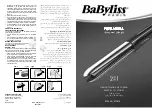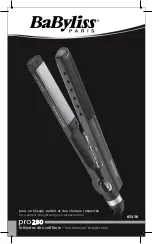
Copies of the I/B. Please reproduce them without any
changes except under special instruction from Team
International USA. The pages must be reproduced and
folded in order to obtain a booklet A5 (+/- 148.5 mm
width x 210 mm height). When folding, make sure you
keep the good numbering when you turn the pages of
the I/B. Don’t change the page numbering. Keep the
language integrity.
Print only what is inside the frame.
6
SIS 40716 - 120501
Assembly page 6/40
Fax +1 305 430 9692
Kind of textile
Temperature dial
Steam ironing
Synthetic
(e.g. acetate,
acrylic, viscose,
polyamide, polyester…)
Silk
MIN
NO
Wool
YES
Cotton
Linen
MAX
YES
•
The table is valid for fiber materials only. If a finish has been
applied (gloss, wrinkle relief etc.), the textile can best be ironed at
a lower temperature.
•
You should sort fabrics according to ironing temperature: wool
with wool, cotton with cotton, etc.
•
The iron heats up more rapidly than it cools down. Therefore, we
recommend that you start ironing articles requiring lower
temperatures first (such as those made of synthetic fibers), then
progress to those requiring higher temperatures.
•
If an article is made of a mixture of different fibers, you should
always select the lowest ironing temperature of the composition
of those fibers. For example an item consisting of “60% polyester
and 40% cotton” should be ironed at the temperature indicated
for polyester and without steam.
•
If you will be ironing delicate fabrics or if you do not know what
kind(s) of fabric(s) the article is made of, test the ironing
temperature on a small, inconspicuous part of the fabric. Always
start at a low temperature and increase as needed.
•
Pure woolen fabrics (100% wool) may be pressed with the iron set
to a steam position. It is recommended that you set the selector
switch to the “Cotton” position, apply shot-of-steam, and use a
dry pressing cloth.
•
When steam-ironing woolen fabrics, shining of the fabrics may
occur. This can be prevented by turning the articles inside out and
ironing the inside or by placing a thin, damp cloth between the
fabric and the iron.







































